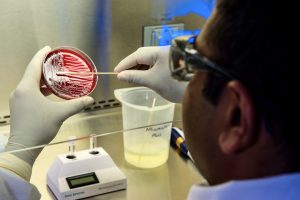Healthcare-Associated (Nosocomial) Infections
Infections acquired in healthcare facilities, including hospitals, are called nosocomial infections or healthcare-associated infections (HAIs). HAIs are often related to surgery or other invasive procedures that provide the pathogen with access to the portal of entry. For an infection to be classified as a HAI, the clients must have been admitted to the healthcare facility for a reason other than the infection within 48 hours of admission (Hannon and Porth, 2016). In these settings, clients suffering from a primary disease are often afflicted with compromised immunity and are more susceptible to secondary infection and opportunistic pathogens. HAIs often occur when pathogens are introduced to clients’ bodies through contaminated surgical or medical equipment, such as catheters and respiratory ventilators.

Estimates suggest that over 220,000 people, approximately 1 in every 9 hospitalized clients, contract a HAI each year with mortality rates fluctuating between 3.2 and 4.3% (per 100 cases), between 2013–2017 (Public Health Agency of Canada, 2019). HAIs can cause symptoms ranging from asymptomatic colonization to septic shock and death. This results in increased suffering for clients and increased healthcare costs for Canadians (Public Health Agency of Canada, 2019). Ensure additional precautions guidelines are followed for all suspected and confirmed cases of infections and communicable diseases.
Common Types of Healthcare-Associated Infections
Below we discuss common types of HAIs. This list is not exhaustive, and you should consult your textbook for additional information about other types of HAIs.
Point of Consideration: Responsible Antibiotic Use
We all play a part in advocating for responsible antibiotic use. As healthcare providers, it is best practice to culture bacteria when possible, to ensure the appropriate and targeted use of antibiotics. It is also important to encourage clients to take antibiotics exactly as prescribed (timing of use and completion of course), and remind clients not to save antibiotics for re-use or for someone else. These strategies can go a long way in reducing antibiotic resistance.
Fun Facts
Before the discovery of antibiotics, TB was the leading cause of death in Canada. A German scientist named Robert Koch discovered the bacterium that causes TB in the late 1800s. Sanatoria were considered the first line of treatment for clients with known TB, which included “rest therapy,” exposure to fresh air, and a healthy diet. In advanced cases, clients received “collapse therapy,” whereby surgeons would actively pump air into the chest cavity so that the lungs could heal (Canadian Public Health Association, 2021). Many healthcare providers contracted TB and were sent to sanatoria across Canada.
Digital Story with Vikky Leung
Attribution
This page was remixed with our own original content and adapted from:
Microbiology by Nina Parker, Mark Schneegurt, Anh-Hue Thi Tu, Philip Lister, Brian M. Forster is licensed under a CC BY 4.0 Licence.

